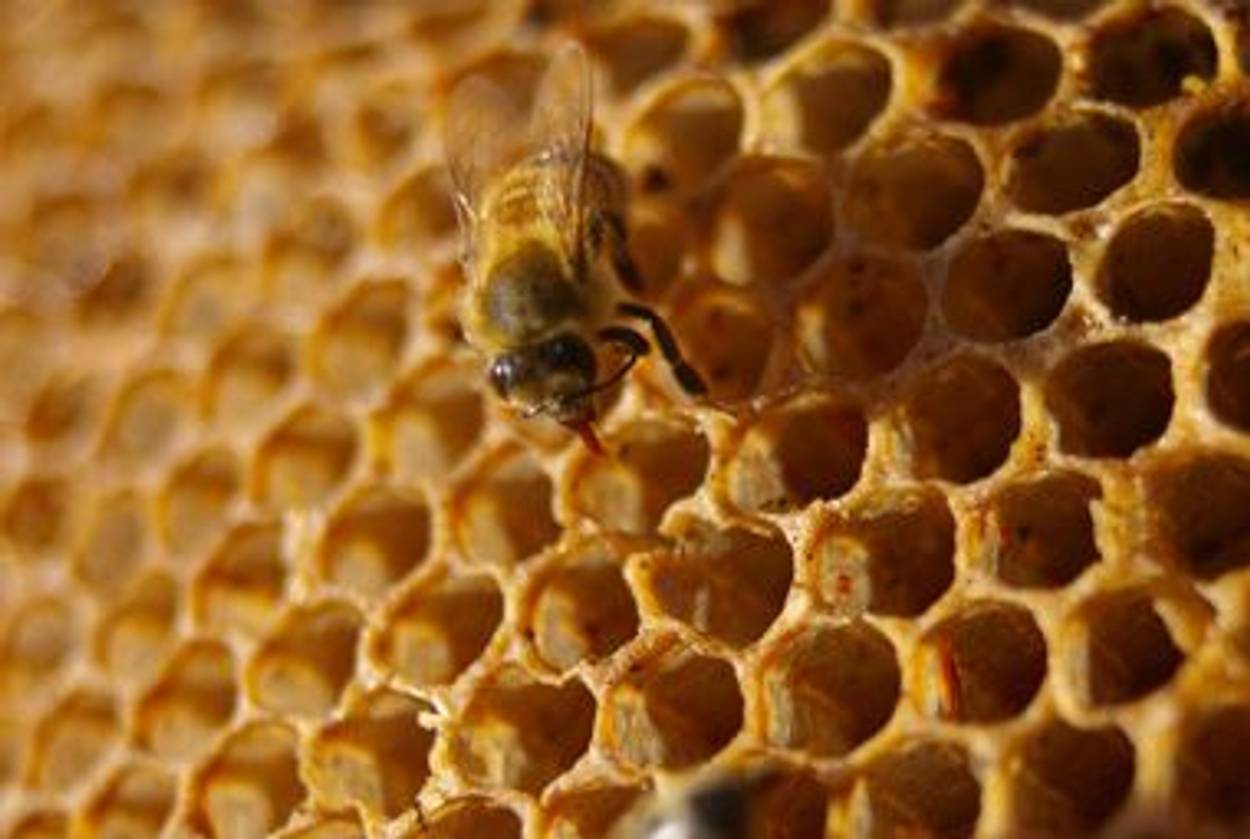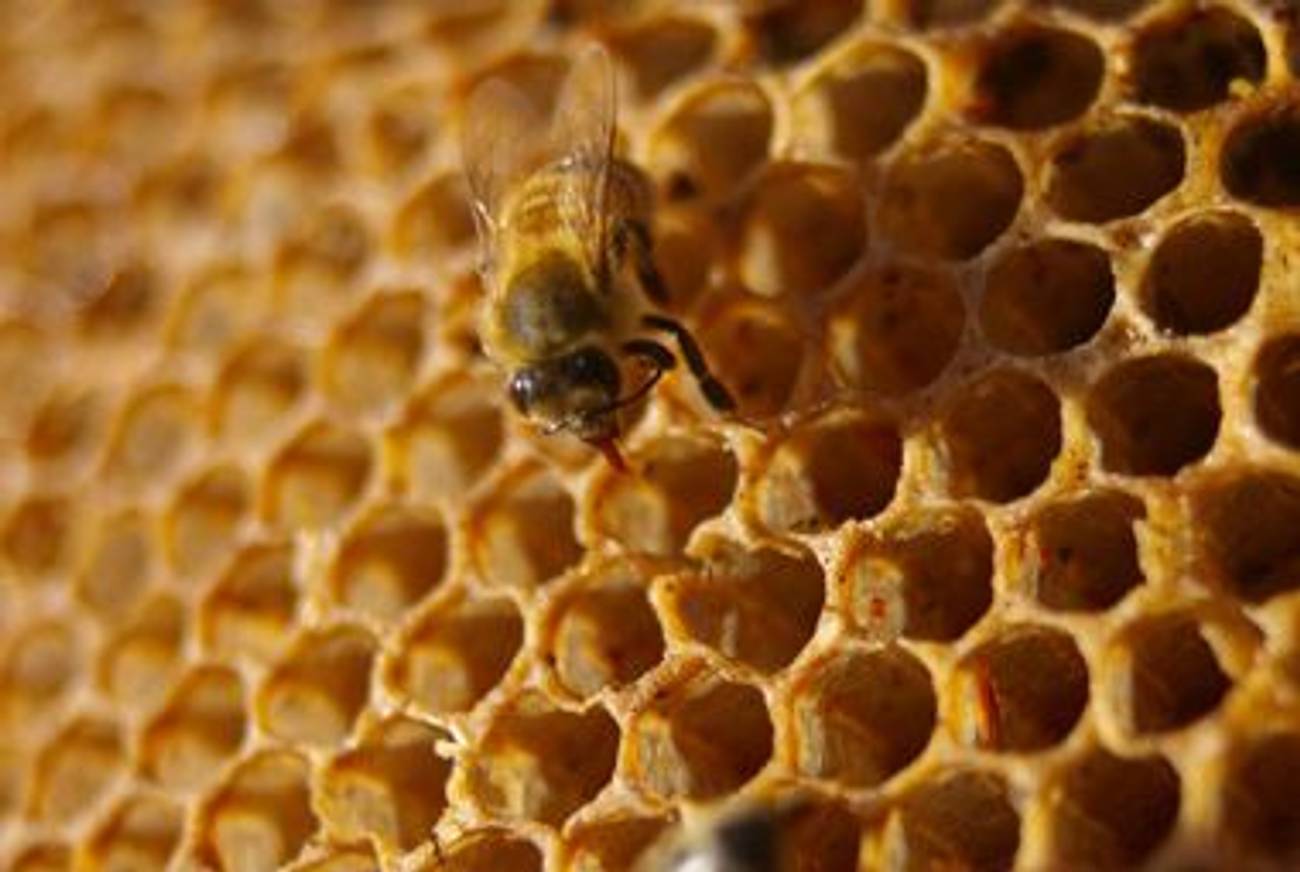Oh, Honey!
A look at Rosh Hashanah’s best sweetener




Whatever else is on your grocery list for Rosh Hashanah, it is almost certain that honey will be at the top of it. The obvious symbolism of a sweet food auguring a sweet new year makes it a natural choice, whether as a dip for apples slices or pieces of the holiday challah—if, indeed, honey has not gone into the dough for the bread that traditionally takes a circular swirl shape this time of year. Clove-scented honey also makes supple syrup for the fried nut-studded knots of dough that are teglach. To me, what’s most important about honey is its role as the key factor in the richly moist, mysteriously dark and spicy cake that has been a holiday fixture in my family for three generations.
Sugar, of course, would be as sweet. But honey has a special place in Jewish culinary history and is mentioned often in the Hebrew Bible. Righteousness is rewarded with deliverance to the land of milk and honey, two of nature’s own foods that provide ready sustenance to humans. It is a promise repeated in both Exodus 3:8 (“And I am come down to deliver them out of the hand of the Egyptians, and to bring them up out of that land unto a good land and a large, unto a land flowing with milk and honey”) and Deuteronomy 26:15 (“Look forth from Thy holy habitation, from heaven, and bless Thy people Israel, and the land which Thou hast given us, as Thou didst swear unto our fathers, a land flowing with milk and honey”), though in Proverbs 25:16, it comes with a warning: “If you have found honey, eat in moderation lest you overeat and vomit.” Gluttons beware.
Although wild honey was treasured in biblical times, the cultivation of bees for honey did not evolve until centuries later. I was surprised to learn that fact many years ago at the enchanting 550-acre biblical landscape reserve Neot Kedumim, which lies close to Ben Gurion airport in Tel Aviv. In Deuteronomy 8:7-10, the abundance of the Holy Land is described by the presence of seven items that grow from the ground: wheat, barley, vines, fig and olive trees, pomegranates, and honey. But bees are animals, and so the Talmudic sages deduced that the honey referred to in that biblical passage was derived from dates. Sampling date honey at Neot Kedumim I found it to have a deep, rich, smoky flavor and a burnished sweetness although it was not nearly as subtly flowery as the bee honey that is now our staple.
In recent years, honey, a popular product in health food stores, has acquired “a health aura,” according to Marion Nestle, a professor of nutrition, food studies, and public health at New York University: “Eat honey if you love the flavor, but it really is only comprised of sugars. The amounts of vitamins, trace minerals, and potassium in it are about equal to those in bottled water—so little as to be almost unmeasurable. Anything sugar will do to you, honey will also.”
As for apples’ part in the Rosh Hashanah ritual, they fit the definition of “new fruit,” supposed to be eaten at the New Year, and taken to mean either a fruit one has never tasted or which is new at the season, and celebrated with a recitation of the traditional shehechiyanu prayer marking first occasions. The apple also has biblical import; in the Song of Songs, Solomon sings, “Beneath the apple tree I aroused your love,” a gentle theme of affection for a new year, and a sentimental forerunner perhaps, of the World War II-era admonition not to “sit under the apple tree with anyone else but me,” popularized by the Andrews Sisters. It is also often assumed that it was an apple that corrupted Adam and Eve in the Garden of Eden, though, in fact, the Hebrew word used in Genesis is pree, or fruit. According to Lytton John Musselman, the author of Figs, Dates, Laurel & Myrrh, a book about biblical plants, it’s unlikely such a fruit was an apple. “It was just too hot and dry for apples to grow,” Musselman said. “They need some cold. Through the years, bible translations from the Hebrew have been done mostly by European Christians who resorted to names of plants they were familiar with. The apple was an enormous favorite.”
Even my family’s beloved honey cake has bibilical roots. Genesis 18:6 tells of Abraham’s hospitality toward three passing strangers. The patriarch tells Sarah, “Make ready quickly three measures of fine meal and honey, knead it, and make cakes.” Having done this apparently to the guests’ satisfaction, Sarah is rewarded by being made fertile in her old age to bear the 100-year-old Abraham the only, much-wanted child of their marriage, Isaac.
I can’t promise a similar miracle if you follow the recipe below, but it will give you much pleasure whether you have it with vanilla or cinnamon raisin ice cream, homemade McIntosh applesauce, or a cup of tea, a glass of red wine, or even a shot of schnaps.
Honey Cake – Lekach
Preheat oven to 325 degrees. Brush peanut oil thoroughly around bottom and sides of the pan. Cut parchment paper to fit the bottom and sides of the pan and brush oil on one side of each strip. Fit paper into pan, placing un-oiled sides against the pan.
Using a heavy-bottomed 2- to 3-quart saucepan, bring honey to a boil, watching carefully every second. Honey boils up and over quickly which is why a large pan and vigilance are required. Let honey cool and then stir in coffee and 2 tablespoons of peanut oil.
Beat eggs with sugar until pale and thick and so that the mixture forms ribbons when dripped back on itself. Stir honey mixture into the beaten eggs. Resift flour with other dry ingredients and gently fold into batter along with grated citrus rinds.
Pour batter into the prepared pan and tap bottom of the pan gently on the countertop to release air bubbles.
Bake for 1 1/4 to 1 1/2 hours, or until top is golden brown and a tester inserted in the center comes out clean. Let the cake cool in the pan. This tastes best if allowed to ripen 24 hours before being served. Once thoroughly cool, cover top of cake with foil or waxed paper and store in a cool place. When serving, peel off only as much paper as necessary for the amount of cake you are cutting.
Mimi Sheraton is a former restaurant critic for The New York Times and the author of several books including The Bialy Eaters.